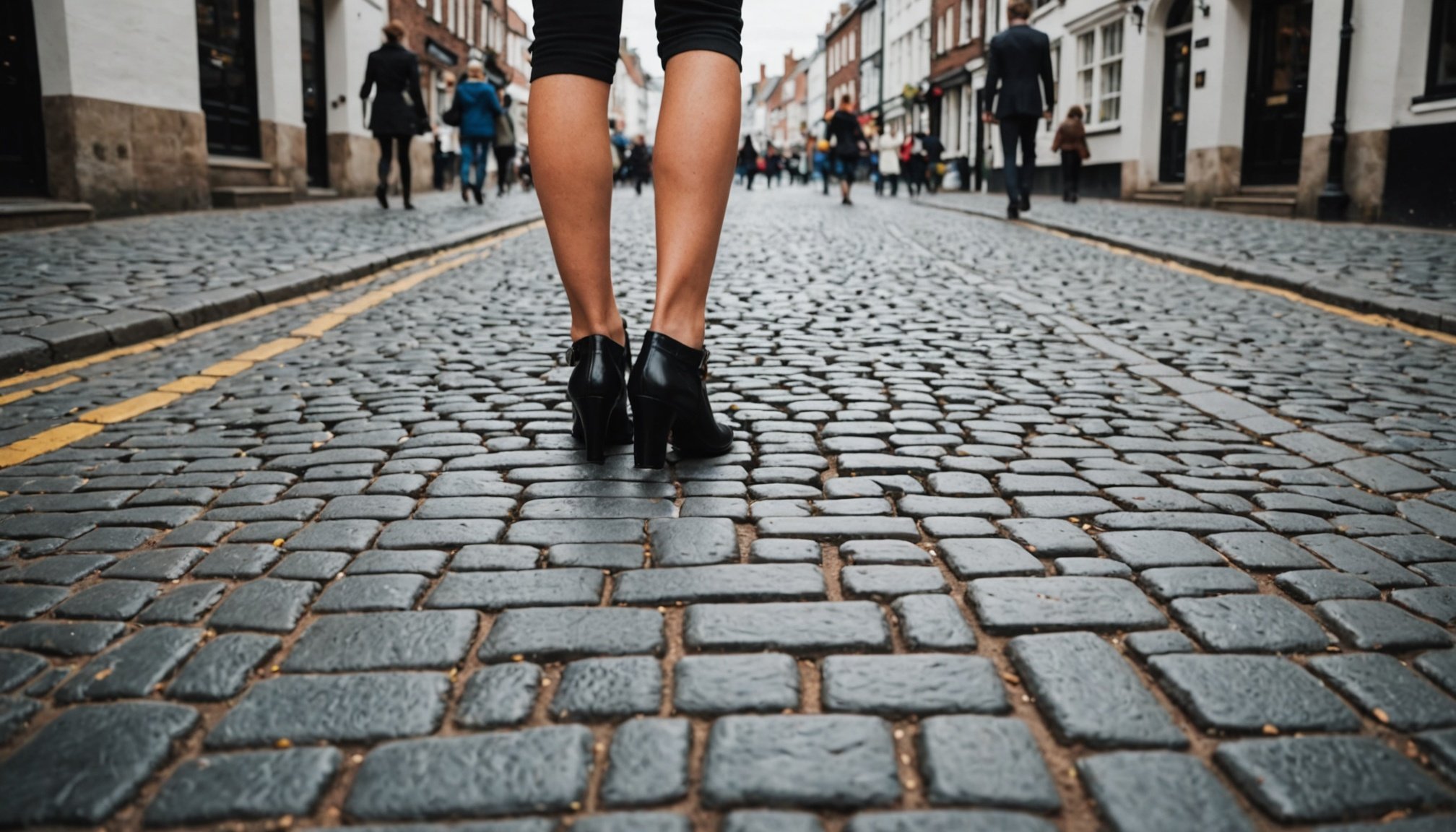Understanding Cobblestone Streets
Cobblestone streets, a staple of many historic towns in the UK, present a unique blend of charm and challenge. These streets are defined by their uneven terrains, consisting of naturally rounded stones set in a bed of sand or other materials. This characteristic contributes significantly to their allure and historical value.
Cobblestone paving has long been an important aspect of the UK’s urban landscape. It dates back to the Roman times, when such roads were the backbone of ancient transport networks. During the medieval era, cobblestones were prized for their durability and ability to withstand heavy traffic and adverse weather conditions. Many historic towns still retain their cobblestone streets, not only for their aesthetic appeal but also for the connection they provide to the past.
Topic to read : Elevate Your Wardrobe: Stylish Ways to Rock a Midi Skirt in Sheffield
However, the beauty of these uneven surfaces comes with its challenges. Navigating cobblestone streets requires careful consideration of shoe choices, as flat and sturdy soles are more suitable to prevent discomfort or injury. Walking style may also need adaptation, with a shorter stride recommended to maintain balance and stability. Despite the challenges, these streets remain a revered element of UK heritage, offering both locals and tourists a tangible link to historic periods.
Choosing the Right Heel Type
When navigating cobblestone streets, selecting the appropriate heel types is crucial. A stable heel ensures both comfort and balance. Chunky heels often top the list due to their broad design, offering better stability. Unlike thinner heels, chunky versions spread weight more evenly, preventing excessive pressure on any one spot.
This might interest you : Mastering Turtleneck Fashion: Create a Cozy UK Winter Look This Season!
The height of a heel plays a significant role in comfort—a heel height that keeps the foot relatively parallel to the ground aids in maintaining balance. Lower heels, typically around two to three inches, are more forgiving on uneven surfaces compared to stilettos. Kitten heels also provide a slight elevation without compromising balance.
Rounded heel shapes, like block heels, are particularly effective for cobblestone wandering. They distribute body weight evenly, reducing the risk of missteps. For those prioritising comfort above all, wedge heels offer excellent support. They provide a broad base and distribute weight over the entire foot.
When balancing fashion with comfort and safety, choose heels that keep you grounded. Consider materials such as rubber or textured soles which increase traction. Ultimately, it’s about marrying style with practicality to enjoy the charm of cobblestone streets without sacrificing confidence.
Selecting Suitable Shoe Materials
When it comes to shoe materials, choosing ones that provide flexibility and comfort is crucial, especially for those who walk on uneven surfaces like cobblestones. These materials must allow the shoe to adapt to the natural movement of the foot, enhancing comfort and reducing fatigue.
Flexibility in shoe materials can be achieved with options like mesh or knit fabrics, which offer excellent adaptability and breathability. Not only does this flexibility support natural foot movements, but breathable materials ensure your feet stay cool and dry during extended wear, significantly improving comfort over time.
Durability is another key factor to consider. Materials like leather or high-quality synthetic alternatives provide robust protection and longevity, ensuring that the shoes withstand regular use on rough terrains without wearing out quickly.
Cushioning plays an integral role by absorbing the impact from hard surfaces such as cobblestones. Cushioning materials like EVA (ethylene-vinyl acetate) or memory foam are effective in shock absorption, minimizing the stress transmitted to the feet and enhancing walking comfort.
- Flexibility and adaptability
- Breathable and lightweight
- Shock absorption and durability
Prioritizing these features in shoe materials results in footwear that not only feels great but performs well in various environmental conditions.
Finding the Perfect Fit
When it comes to selecting shoes, understanding how to achieve the perfect shoe fit is paramount. Ensuring your footwear is the right size not only enhances comfort but also supports foot health over time.
Proper shoe sizing tips begin with accurate measuring techniques. A Brannock device, often found in shoe stores, can help measure both foot length and width, which are crucial for a satisfactory fit. It’s recommended to measure your feet at the end of the day when they are slightly swollen to ensure you don’t purchase shoes that are too tight.
For those who enjoy prolonged walking, it is essential to identify shoes that offer robust foot support. Foot support plays a crucial role in reducing fatigue and preventing injuries. Choose shoes that have ample cushioning, particularly around the heel and arch areas, to absorb shock and distribute pressure evenly.
Additionally, consider the type of arch support you require. People with high arches or flat feet might benefit from custom insoles. These insoles can provide tailored support and reduce discomfort, allowing for a more pleasurable walking experience.
Remember, a great fitting shoe is one that accommodates both size and support needs, ensuring lasting comfort throughout your activities.
Strategies for Walking on Cobblestones
Navigating cobblestones can be a challenging endeavor, but with the right walking techniques, maintaining balance is achievable. Key to safeguarding oneself on uneven surfaces is adopting a methodical approach to movement and staying aware of your surroundings.
Walking Techniques and Balance
To effectively conquer the cobblestone streets, focus on taking short, deliberate steps. This method reduces the risk of losing your footing. Ensure each footstep is taken with caution, distributing your weight evenly to stabilize your balance. Concentrate on stepping on the flattest stones to mitigate the possibility of tripping.
Recommended Body Posture
Correct body posture significantly contributes to maintaining balance. Engage your core muscles and keep your body upright. A slight forward lean can sometimes aid in keeping control, especially when navigating downhill areas. Keep your arms free for balance support instead of carrying bulky items or heavy bags.
Overcoming Obstacles
Safety tips for hurdling curbs and irregular pathways include scanning your path well in advance. It’s advisable to slow your pace when approaching such obstacles. For higher curbs, use your leading foot to first test and feel the surface before committing fully. This technique aids in anticipating potential mishaps and maintaining a steady footing throughout your journey.
Footwear Care for Cobblestone Conditions
Navigating cobblestone streets can be a formidable challenge for your shoes. To maintain their longevity and appearance, it is essential to adopt effective shoe care practices. Begin by cleaning your shoes after each walk on cobblestones. Use a soft brush or cloth to gently remove dirt and debris. This prevents buildup that could damage the materials over time.
To tackle weather-related issues, consider using waterproofing sprays specifically formulated for your shoe material. Leather and suede require different products, so it’s crucial to choose the right one. Regularly applying these sprays helps shield your shoes from moisture, extending their durability and maintaining their look.
In addition to waterproofing, investing in protective products like shoe creams can aid in preserving the shoe’s structure and color. These products not only condition the material but also keep the shoes looking fresh and new.
When dealing with heels, examine the shoe’s soles for wear and replace them as needed. Treads can be worn down quickly on cobblestones, so keeping an eye on this is vital for safety and support.
Using these maintenance strategies will enhance the shoe’s lifespan and allow you to enjoy your favorite footwear longer, even on cobblestone terrains.
Suggested Brands for Heels
Selecting the right shoe brands that balance style and comfort can transform your footwear experience. Several brands have garnered a reputation for producing heels that are both fashionable and easy to wear, ensuring your feet feel as good as they look.
Clarks often ranks highly for those prioritising comfort without sacrificing aesthetics. Known for their cushioned insoles and supportive designs, Clarks provides options suitable for both everyday wear and special occasions. Feedback from wearers consistently notes the longevity and comfort of their shoes, making them an attractive choice.
For those inclined towards high-end designer flair, Jimmy Choo stands out with its blend of luxury and style. Although at a higher price point, the craftsmanship and elegance of their heels often justify the investment for fashion enthusiasts. Users laud the brand for its statement-making designs and the superior comfort offered by their innovative technology, ensuring you don’t have to compromise on style.
For budget-conscious shoppers, Nine West offers an impressive array of trendy options without breaking the bank. This brand excels in providing stylish aesthetics alongside comfortable fits, making it a favourite for many. Reviews highlight an array of colours and styles, suitable for various occasions while remaining cost-effective.
Visual Aids and Testimonials
Navigating cobblestones in style can be quite the feat, but real-life experiences shared by users provide invaluable insights. Visuals showcasing various heel styles are particularly helpful for those looking to balance style and practicality. For instance, images of block heels or sneakers on cobblestones offer a clear depiction of options that combine elegance with stability.
User feedback often highlights personal stories of success and failure in choosing appropriate footwear. Reviews brim with engaging stories about days out in cities with charming, but tricky pavements. These narratives underline the importance of making informed choices based on first-hand experiences.
- Visuals can guide decision-making by presenting potential shoe choices in action.
- Testimonials enrich the learning process, emphasizing styles that work well in real scenarios.
Incorporating both visual and written feedback creates a more holistic understanding. Users frequently express a sense of confidence when they find the right shoe that marries fashion with functionality. This practical guidance, backed by images and personal anecdotes, empowers readers to make savvy decisions, ensuring both their style and comfort are uncompromised.











